Release Notes for the Vector Generation 2
1. Why did we make a Generation 2 version of the Vector?
The first Vector design was released in March 1999. Since its release, Doppler technology has improved, and some components required to make it have become obsolete. Nortek took this opportunity to improve the performance and design of the Vector and maintain its position as a reliable current, wave, and turbulence measurement sensor for years to come. In 2025, the legacy version of the Vector was replaced by the new Generation 2 Vector.
While our goal is to ensure the transition to the new Generation 2 Vector is as seamless as possible, there are some key differences that should be considered. This document outlines these differences.
2. Available configuration
The Generation 2 Vector is a compact velocimeter that can measure currents, waves, and turbulence. Its integrated design includes features that were previously optional in the legacy Vector. The simplified configuration ensures consistent functionality across deployments, reducing complexity in ordering, setup, and field integration. Currently there is one version of Generation 2 Vector, and it is rated at 300 m water depth. Below is a general layout of the Generation 2 Vector.
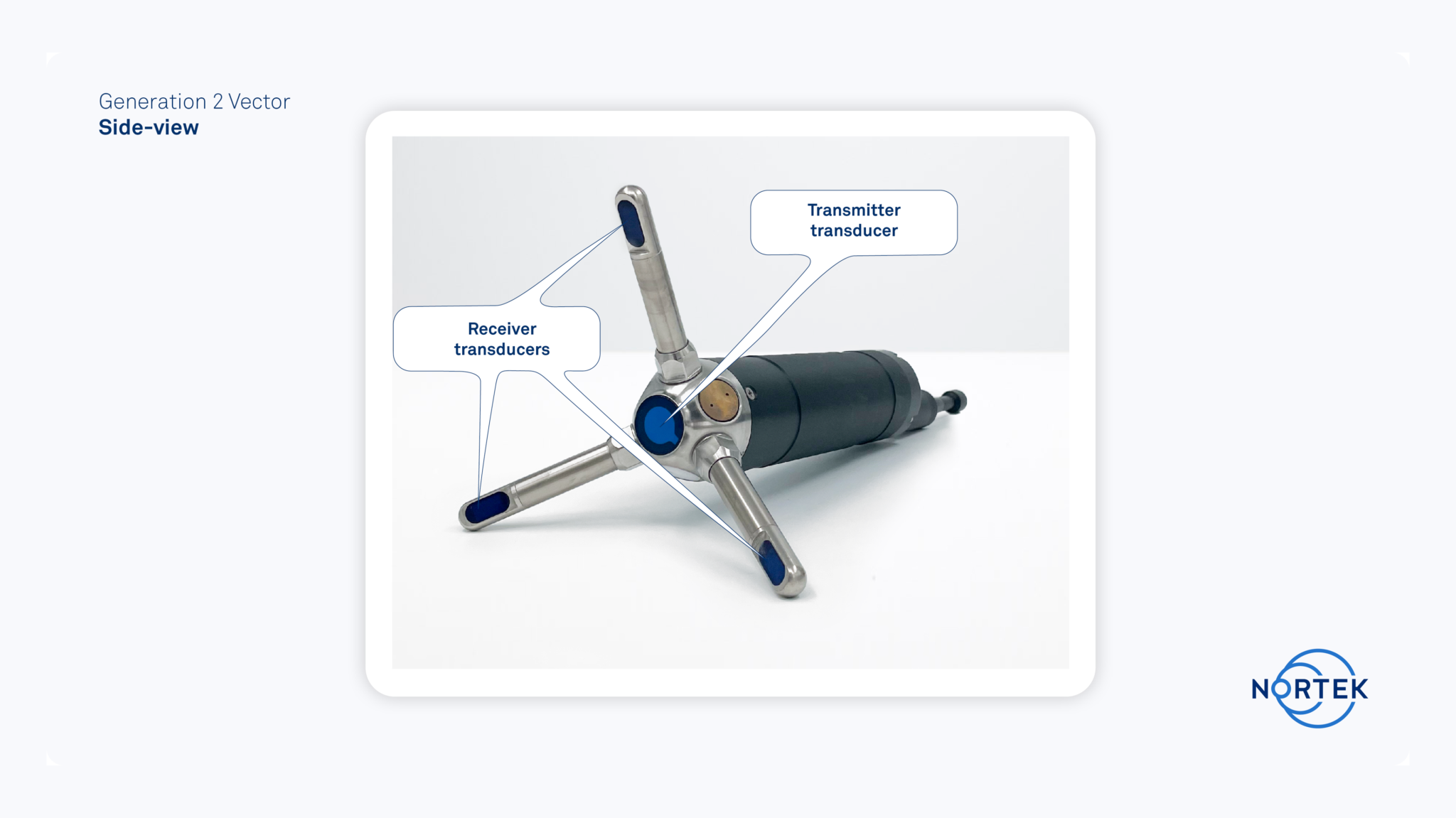
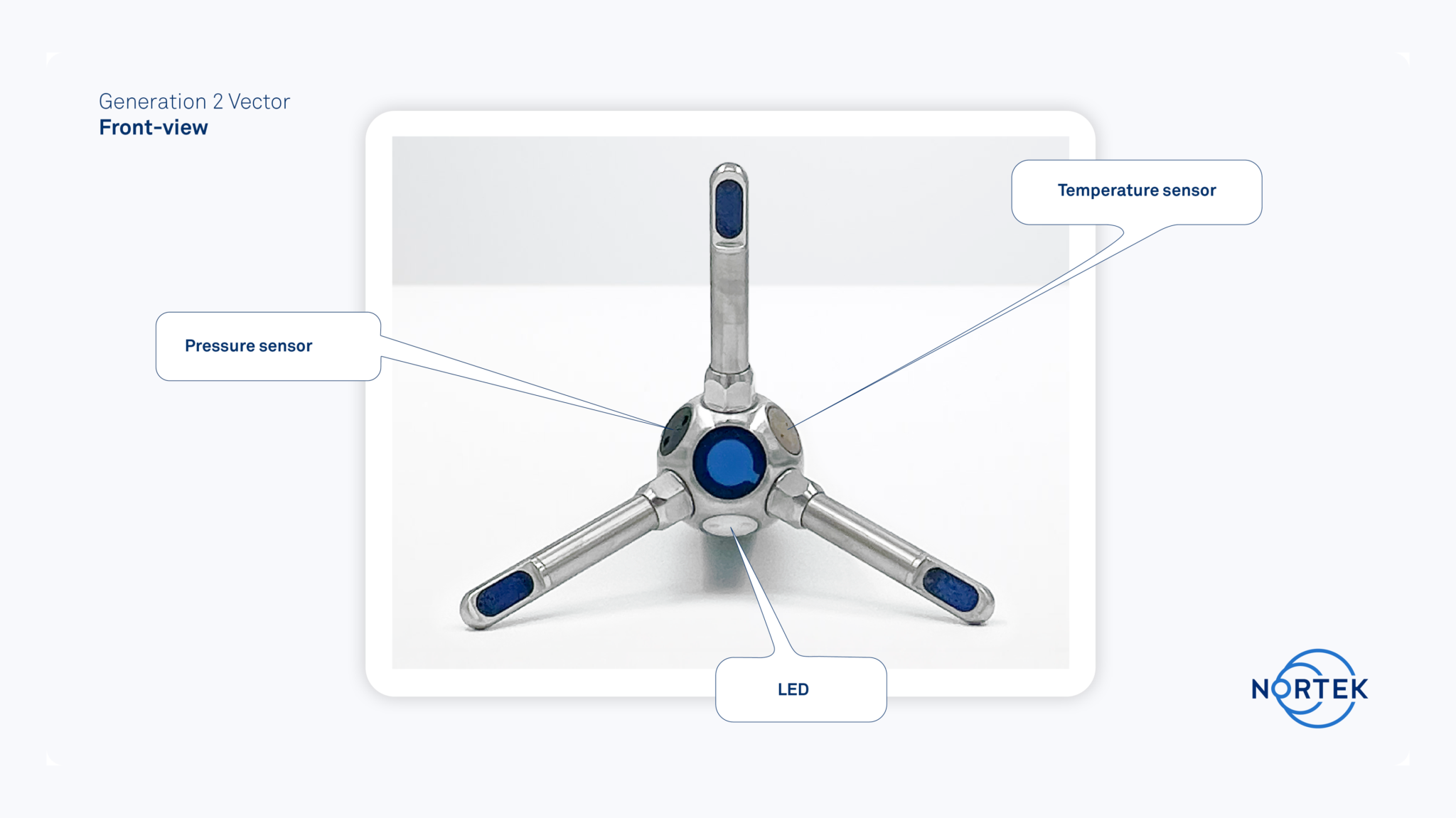
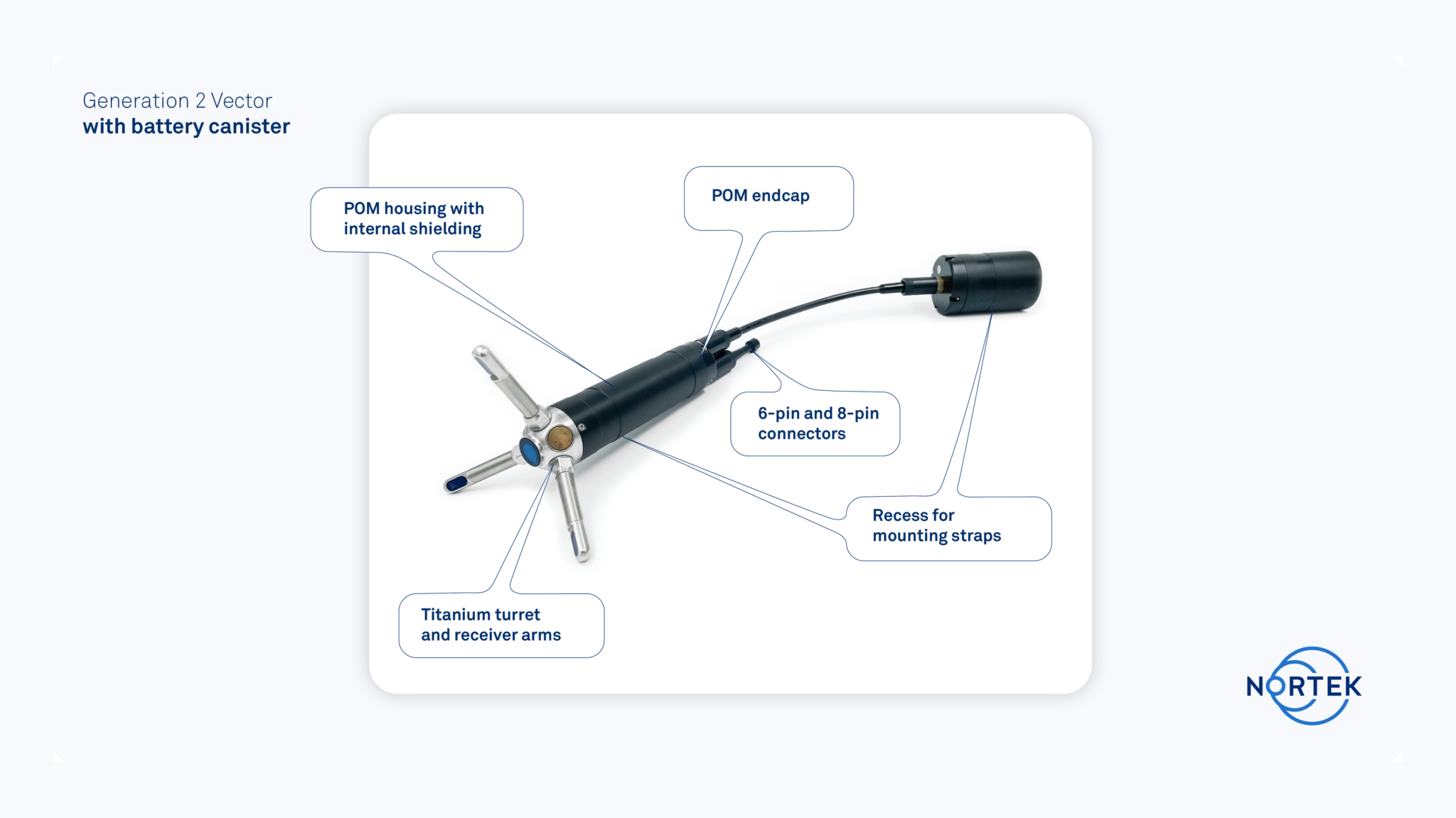
3. Physical updates
Below is a summary of the main physical updates to the Generation 2 Vector.
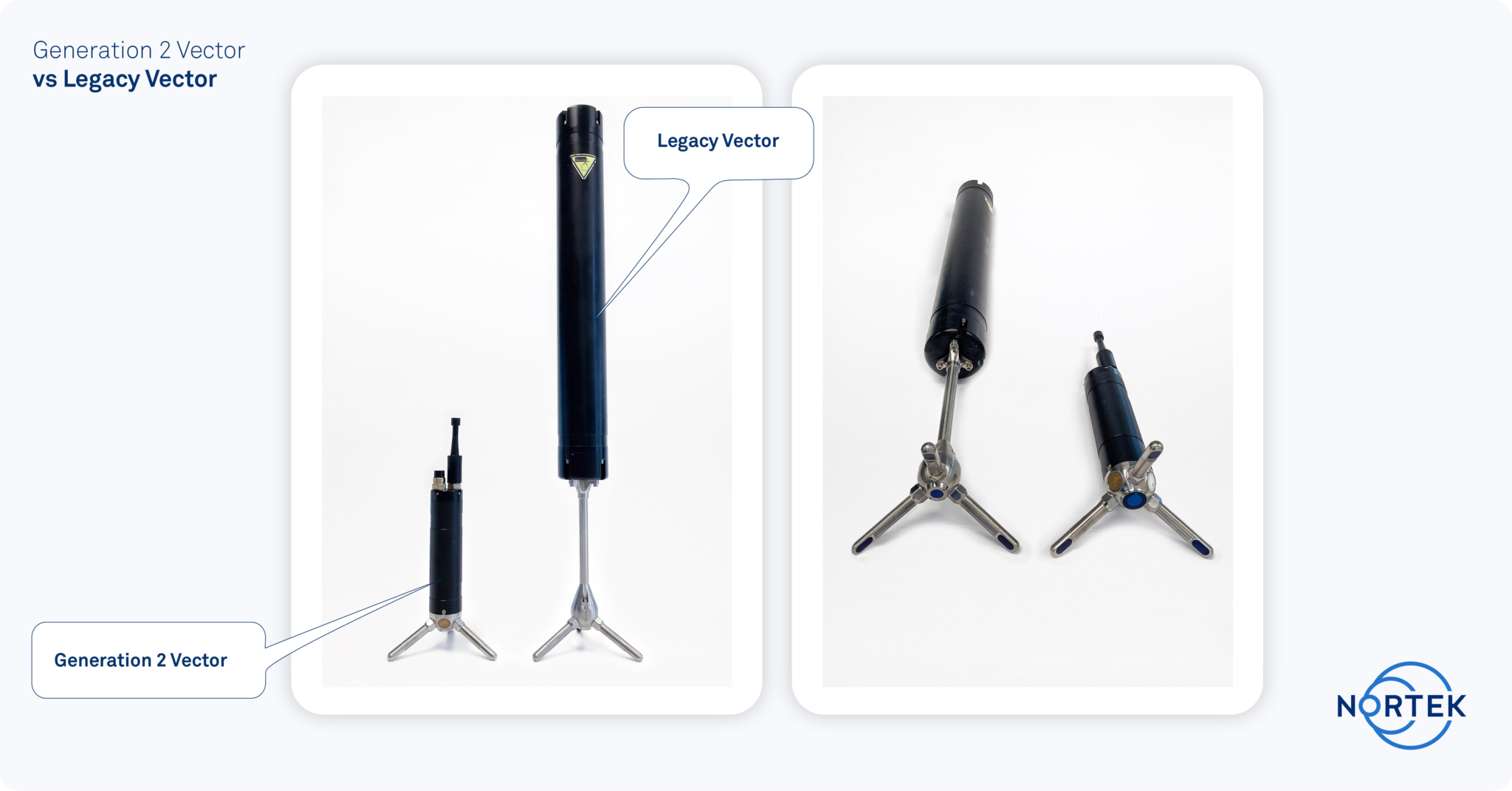
- Smaller form factor: The instrument’s diameter has been reduced from 75 mm to 48 mm, and length has been shortened from approximately 700 mm to 250 mm, resulting in a significantly smaller footprint. Pictured above is the legacy Vector next to the Generation 2 Vector. This new smaller size now allows the Vector to be deployed in areas previously inaccessible to the legacy version.
- Lightweight construction: Weight reduced from 2.3 kg to 690 g in air, making the instrument easier to handle, transport, and deploy, especially on autonomous platforms or in tight spaces.
- No stem: The Generation 2 Vector lacks the traditional rigid stem connecting the turret (the central piece that holds the three receiving arms and ancillary sensors) to the instrument housing. This is because the instrument’s housing is now significantly smaller, thus negating the need to separate it from the housing to avoid flow disturbance issues. The smaller housing also enables more flexible instrument positioning, so there will be no cable probe option for the Generation 2 Vector. Nortek has performed extensive CFD modeling of the new housing’s form factor and concluded that it does not present any more flow disturbance than the legacy Vector’s form factor. Additionally, the same care and high-quality calibration procedures applied to the legacy Vector are also applied to the Generation 2 Vector.
- Larger transmit transducer: In the Generation 2 Vector, the central transmit transducer has been upgraded from the original design. It now functions as a broadband transducer with improved performance and can also operate as a receiver when required. The three angled receiving transducers remain unchanged from the legacy Vector design.
- No internal batteries: The significantly reduced size also means there is now no room for internal batteries in the Generation 2 Vector. Instead, a small external battery canister is available for standalone deployments, pictured below. This small canister holds a 76 Wh Li-Ion rechargeable battery capable of powering the Vector for over 48 hours of continuous measurement at 32 Hz sampling rate at maximum power, or about two weeks on 10-minute hourly bursts. For users who desire more battery power, Nortek also offers a wide range of battery canisters and battery packs compatible with the Generation 2 Vector, including canisters interchangeable with the Generation 2 Aquadopps.
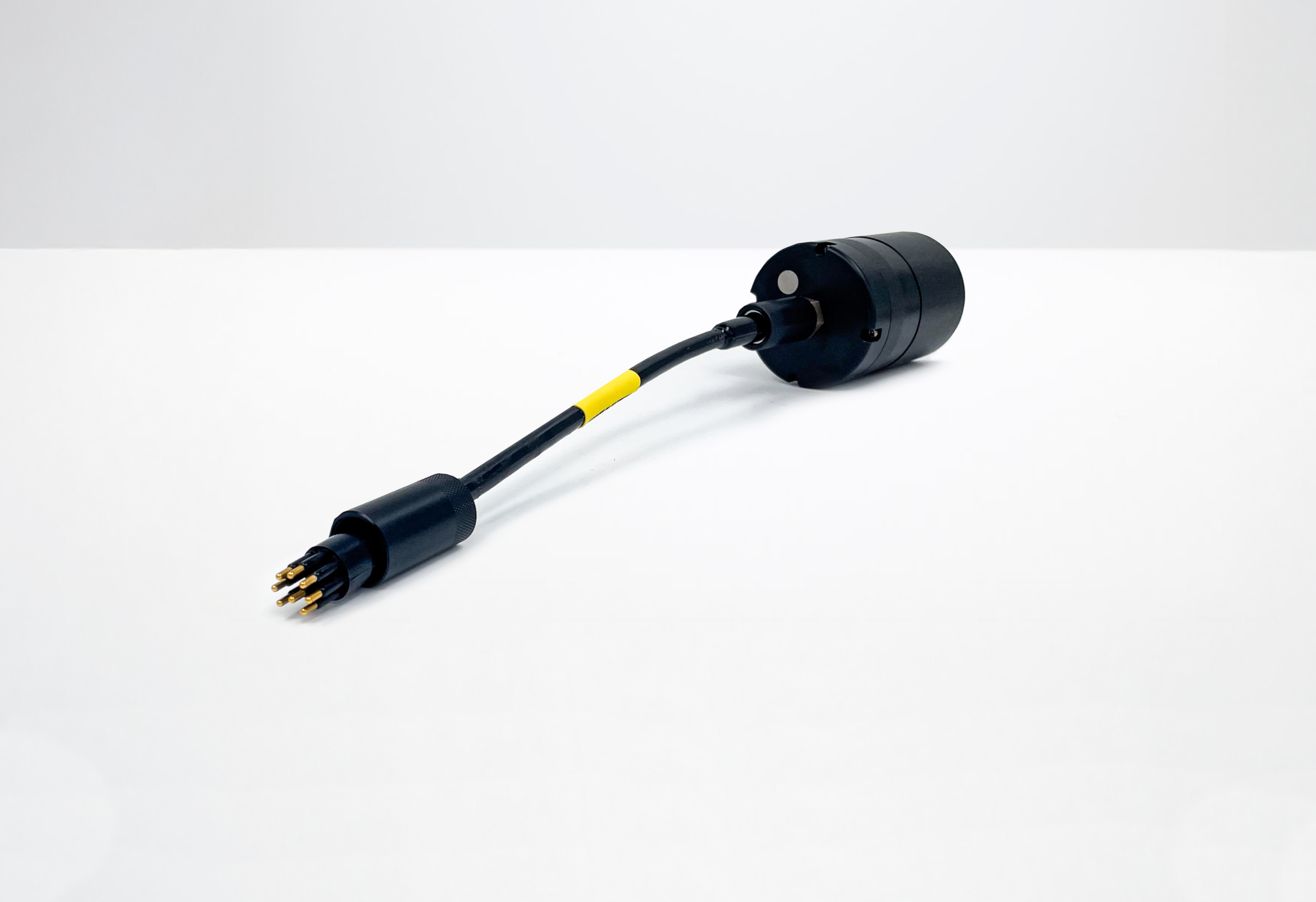
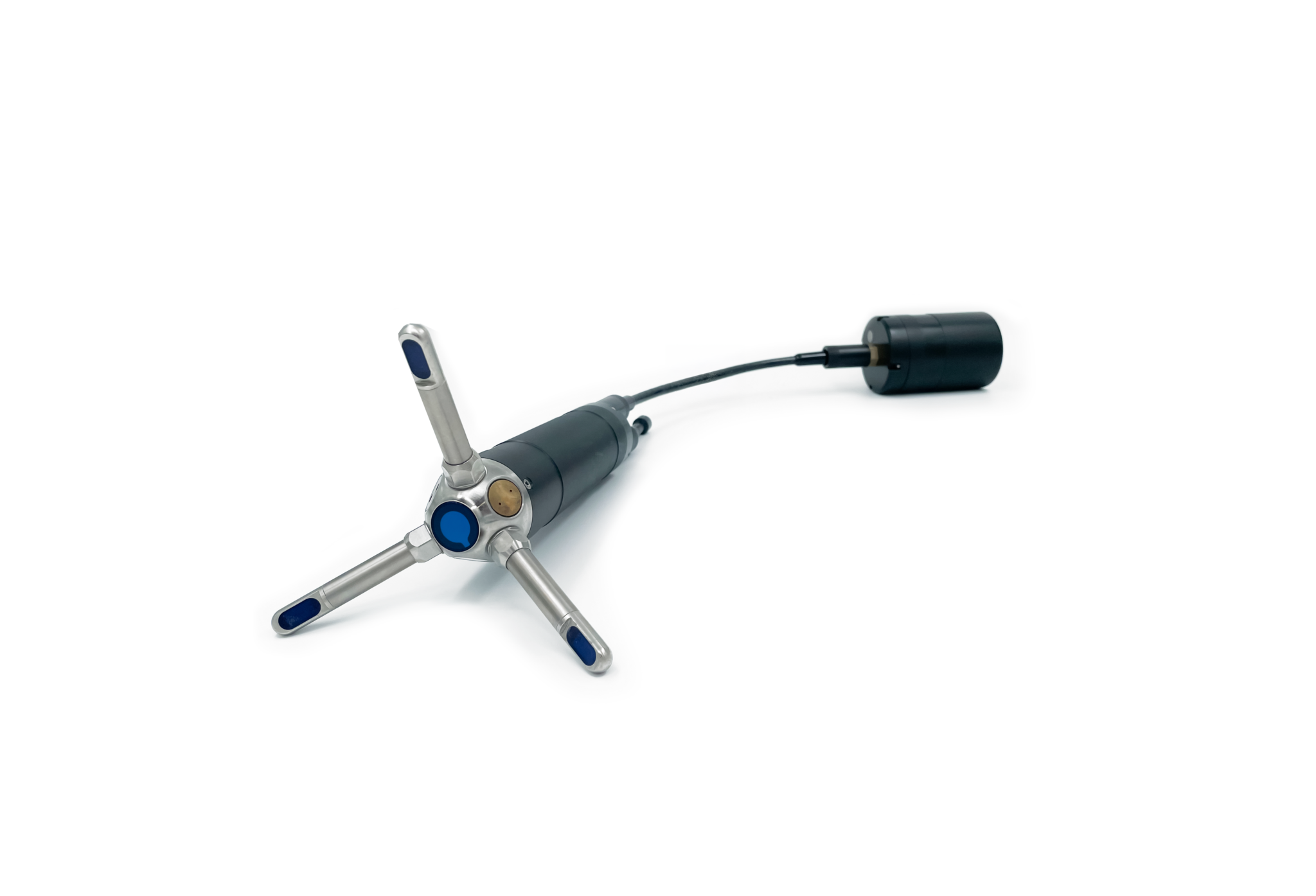
- Two bulkhead connectors standard: The Generation 2 Vector has two MCBH-FS connectors on its endbell: one 6-pin and one 8-pin connector. The 8-pin connector is used for all communications and power supply. The 6-pin connector is used for external sensors' power and communications, and synchronization options.
- Temperature and pressure sensor in turret: The legacy Vector has both the temperature and pressure sensors embedded in the plastic endbell at the base of the stem. The Generation 2 Vector has both these sensors in the turret, which is the center piece where the three arms are connected (see Fig. 1). This means that temperature and pressure readings are now much closer to the actual sampling volume. Additionally, the thermistor is now embedded in a bronze pin directly exposed to the water, providing a faster response rate to temperature changes.
- LED: Following Nortek’s established tradition of providing an external indicator light, the Generation 2 Vector has an LED on the turret (see Fig. 1). The LED illuminates when power is applied, and it blinks at the user-defined sampling rate to indicate it is collecting data.
4. Electronic Updates
Below is a summary of the main updates to the electronics of the Generation 2 Vector.
- Modern electronics: The instrument electronics have been completely redesigned, taking advantage of modern System-On-Module architecture, making them significantly more powerful and advanced. The updated electronics are more immune to noise, resulting in enhanced measurement precision for a given power consumption. Additionally, to protect against unnecessary exposure, the electronics are now fully enclosed and inaccessible to users.
- Broadband: While all Doppler velocimeters use the Pulse-Coherent method – see Principles of Operation: High Resolution manual - for estimating velocity, previously the legacy Vector only had the option of transmitting narrowband pulses to be used in this scheme. The Generation 2 Vector now has broadband technology which gives a much higher precision per ping. The Generation 2 Vectors can be configured with 25% bandwidth (“broadband”) for improved precision, in addition to the traditional 6% bandwidth (“narrowband”) for more reliable operation in water with fewer scatterers.
- Parallel receiving: The legacy Vector operated using a multiplexed pinging scheme, where each receiver beam was activated in sequence—meaning that pulses were received at each receiver one at a time (see Fig. 4). This approach minimized acoustic crosstalk between beams but imposed limitations on sampling rate and temporal resolution. The Generation 2 Vector introduces simultaneous beam receiving, allowing all beams to receive the transmitted pulse at the same time. Therefore, it takes 1/3 the amount of time to complete the same ping sequence, improving temporal resolution. This performance improvement means the Generation 2 Vector’s internal sampling rate—the actual rate at which the transmit transducer sends pulses—has been increased to 703 Hz per beam (vs. 250 Hz per beam for legacy Vectors), resulting in higher precision measurements over the same time.
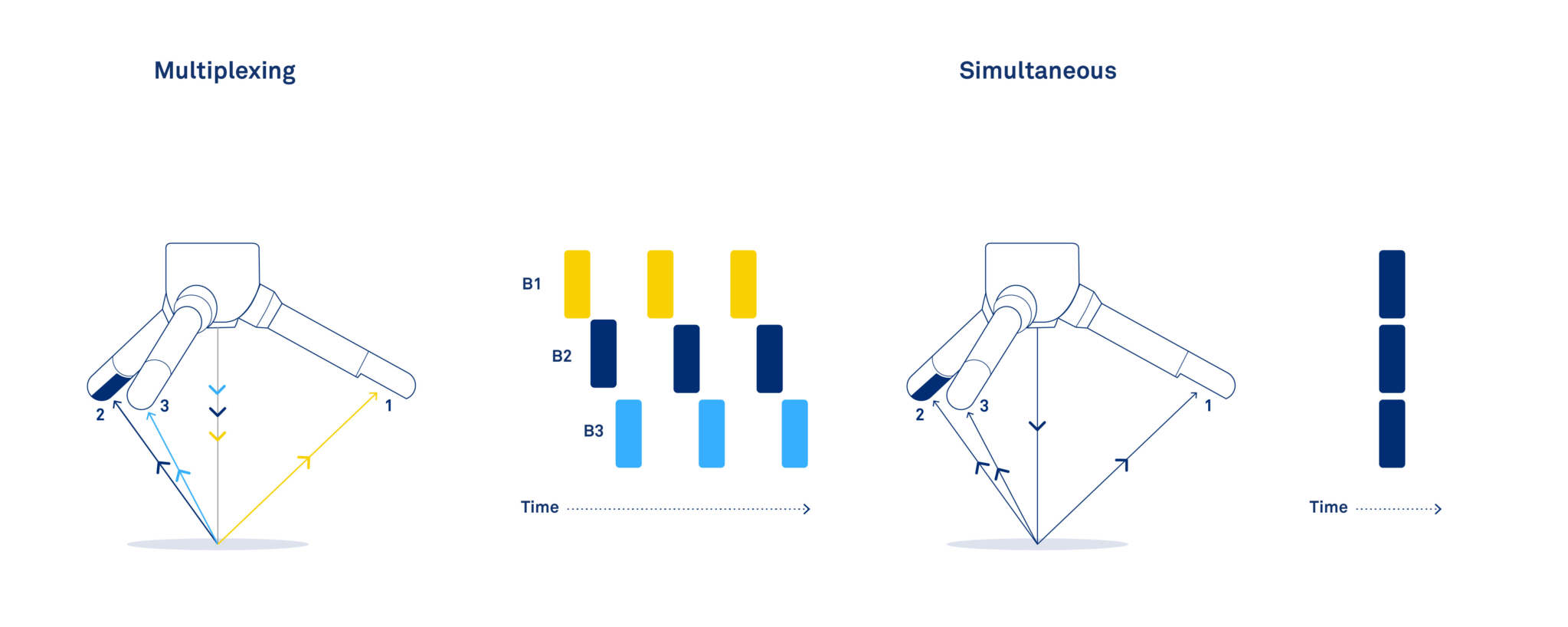
- Ethernet and serial communications: Similar to Nortek’s Signature Series, the Generation 2 Vector supports both Ethernet and serial (RS-422) communications, but unlike the Signature Series, where each protocol requires a separate cable, the Generation 2 Vector offers an interface box that supports both these protocols using a single cable to the instrument. The Vector interface box allows users to easily switch between serial and Ethernet modes. An integrated LED indicator provides a clear visual cue of the active connection type. The box includes a power input, serial and Ethernet ports, and a dedicated instrument communication port for connecting to the Generation 2 Vector.
- Note that cables for the Generation 2 Vector and the Signature Series are NOT interchangeable, and that cables from legacy Vectors will NOT work on the Generation 2 Vector.
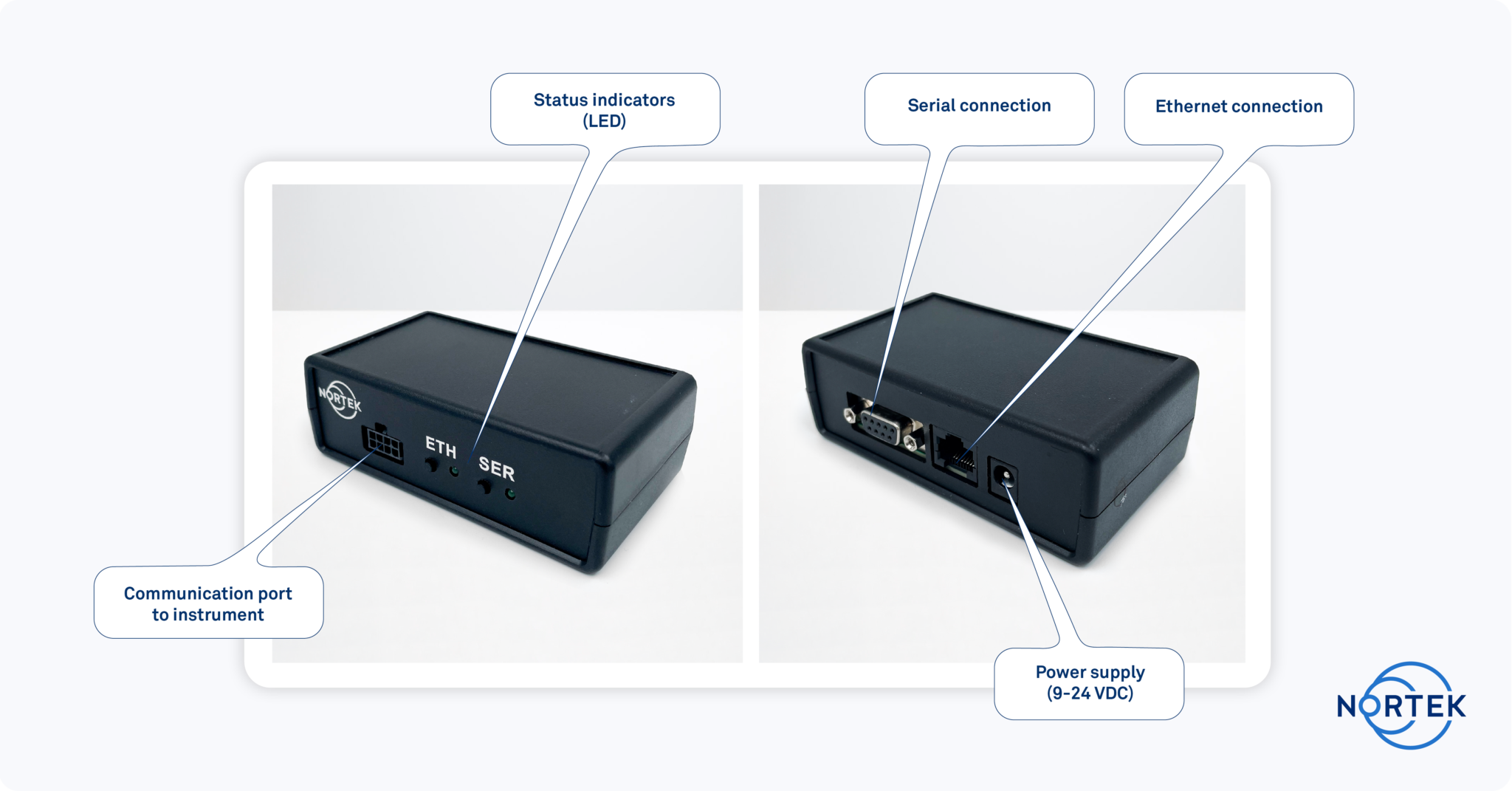
- Higher input voltage: Expanded input voltage from 9–15V (legacy) to 9–24V (Generation 2), allowing greater flexibility when powering the instrument from various external sources or digital systems, and providing greater flexibility in system integration projects.
- Larger memory: The Vector can now be configured with up to 512 GB of internal memory storage, greatly extending deployment duration due to memory limitations.
5. Functionality Updates
- Echosounder: A short-range echosounder mode has been added to the Generation 2 Vector. Operating on the center transmitting beam, the echosounder mode allows users to image structures in the water column in the path of the beam. This functionality is useful for anyone looking at sediment transport or changes in bottom morphology.
- Fast-response tilt & heading sensor: Instead of a liquid tilt sensor, the Generation 2 Vector now supports a full 360° tilt and heading sensor. The supporting electronics for this are native to the instrument and offer static tilt and heading data. For dynamically moving platforms, Nortek will offer a licensed firmware upgrade to a full AHRS (Attitude and Heading Reference Sensor) which will allow it to be used in dynamic settings. Contact your local Nortek Representative if you are interested in this upgrade when it is available. Note the instrument does not need to be sent back to the factory; it only needs a license key.
- Fast oxygen sensor: For Eddy Covariance systems, Nortek has implemented the option to integrate a user-supplied PyroScience AquapHOx-T Transmitter. The AquapHOx is treated as a digital external sensor to the Vector, where the Vector supplies power, sample timing, and data storage to the AquapHOx.
- Improved correlation output: The correlation parameter, used to assess data quality, now has enhanced resolution, from 1% to 0.01%. This provides better insight into measurement reliability. More details can be found in the Principles of Operation – Currents manual.
- Spectrum analyzer: A spectrum analyzer option is now available in the software to assess external noise, a helpful tool during system integrations or for online applications.
- Full-rate sensor sampling: All sensors, including velocity, pressure, temperature, tilt, and heading, now sample at 64 Hz, delivering highly synchronized and high-resolution time series across all channels. And, unlike the Legacy Vector, the Generation 2 Vector produces a time stamp for each individual sample, at nanosecond resolution, for sampling rates up to 64 Hz
- Extended velocity range: The Generation 2 Vectors introduce Extended Velocity Range (EVR) as a new standard feature to enhance performance in higher-velocity and turbulent environments. EVR extends the maximum measurable velocity without sacrificing precision by using two pulse pairs with different time lags: a shorter lag provides a coarse velocity estimate, while a longer lag provides a high-accuracy measurement. By comparing these two measurements, the instrument resolves phase ambiguities and effectively increases the measurable velocity range. EVR settings are automatically optimized based on the selected application, but the suggested velocity range can also be adjusted manually through the command interface in the deployment software.
- ASCII-based command interface: Generation 2 Vectors now have a more comprehensive, ASCII-based command interface, allowing for better control through loggers. For those who are familiar with the Signature series, the command interface uses similar principles.
- Data files: To support the added functionality, the data structure of the Generation 2 Vector is completely different from its predecessor. Each autonomous deployment is stored inside the Vector’s internal memory card and has a .vec2 extension.
- New XYZ coordinate definition: The Generation 2 Vector has a different XYZ definition from the legacy Vector (see Fig. 6 below). This change was made to make the Generation 2 Vector coordinate definitions match the rest of Nortek's ADCP systems.
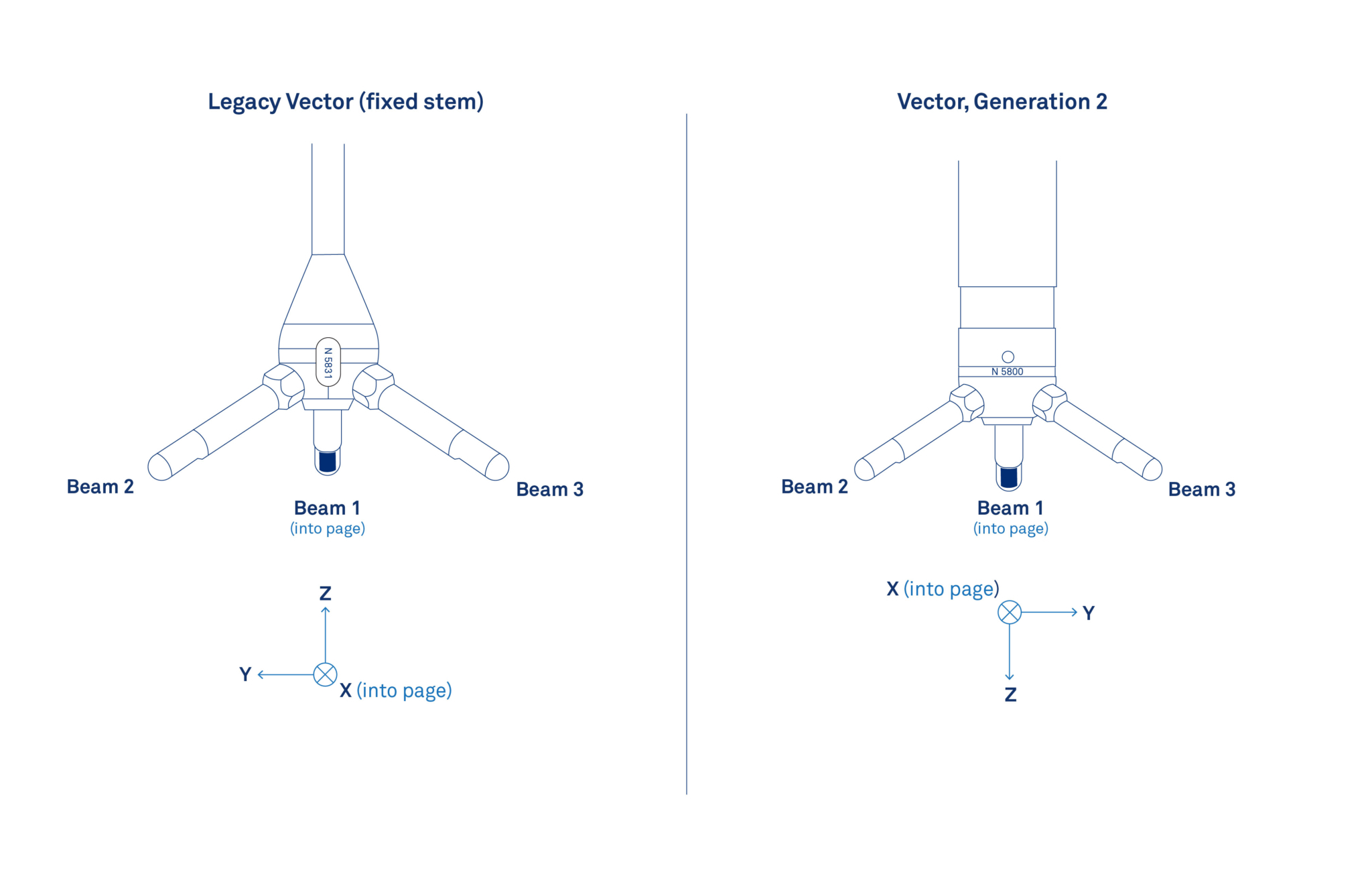
6. Nortek Deployment software
The Generation 2 Vector is configured exclusively using Nortek Deployment, Nortek’s web-based deployment and setup software, accessed via https://deployment.nortekgroup.com/. This modern software replaces the legacy Vector interface and provides a streamlined, user-friendly experience across all current-generation Nortek instruments. Nortek Deployment offers a simplified workflow for configuring instrument parameters, managing sensor settings, and initiating deployments. The software can also be installed from the Microsoft Store or downloaded as an offline installer file from the Nortek website.
Note: For the Generation 2 Vector, serial communication supports everything except data download and firmware update, both of which require Ethernet communication. Additionally, Ethernet communication does NOT support live data acquisition.
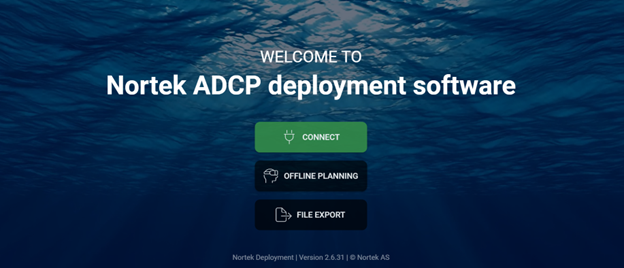
Below are the key features of this software:
- Comprehensive help guide: Detailed information on how to operate the instrument is found in the software “Help” section. The content of the help guides changes based on which page you are currently viewing in the software, with relevant information appearing for each step of the configuration process. Additionally, users can search FAQs directly in the software without having to revisit our website. Finally, the software’s Support section contains helpful links to external resources such as GitHub, our social media platforms, and our Support site.
- Multiple modes of access: The Nortek Deployment software can be accessed via web or downloaded from your preferred app store (Windows users only). Access the Nortek Deployment Software from any operating system, including Windows and Mac iOS, by using the web application.
- Full data export: To allow for data visualization, the Nortek Deployment software supports full conversion of the native binary format (Nortek DF8) to either ASCII-readable CSV files or directly to MATLAB. Two different export levels are available to expedite conversion of larger files when only the key parameters are desired. Coordinate transformation is also supported as part of the data export process.
- Command log: The commands issued to the instrument can be viewed in the collapsible command log in the software. By enabling “Advanced” mode, you can also send commands to the instrument via this command log.
- Diagnostic mode: A spectrum analyzer is available by enabling Advanced mode. This feature is helpful when assessing external noise, specifically during buoy integration or online applications.
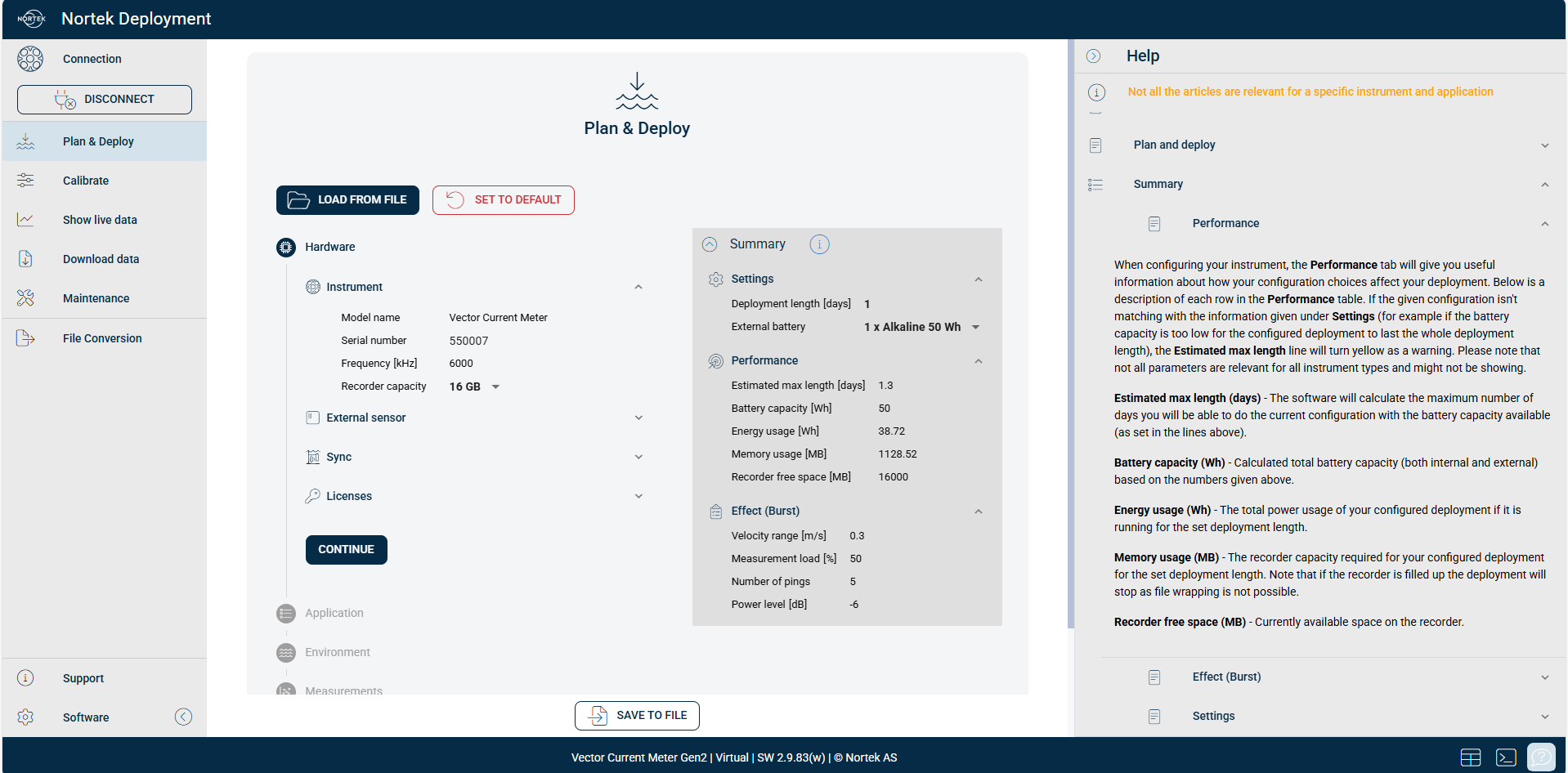
7. Frequently asked questions
- Can I still use my existing Vectors? Are these instruments still supported?
- Yes, the legacy Vector still works and functions as intended. The lifespan of these instruments can be over a decade as long as they are well cared for. We plan to provide technical support for these original instruments for as long as possible, but any physical service and repairs are subject to the availability of obsolete parts and components.
- Can I still purchase spares (batteries, cables) for my existing instrument?
- Yes. We will continue to stock batteries and cables for the original instruments, but these are subject to availability of parts and components.
- Does the Generations 2 Vector Support Analog inputs/outputs?
- No. The Generations 2 Vector does not support analog outputs. Also, the analog inputs have been upgraded to a single digital input, which presently supports the PyroScience AquapHOx Transmitter, to be used in Eddy Covariance systems. Additional fast oxygen sensors, with digital interfaces, will be supported in the future.
- Can I still purchase replacement parts for the original design?
- Yes, but these are subject to availability of obsolete parts and components. Typically, we expect that replacement parts will be available for a couple more years, but if you are concerned about longevity, it is better to switch to a new Generation 2 instrument sooner rather than later where possible.
- Are there any manuals available for the Generation 2 Vector?
- A comprehensive help guide and details on how to operate and configure your instrument is found within the Nortek Deployment software. In addition to the Help sections in the software, the following relevant manuals are available in pdf on our support site:
- Principles of Operation - High Resolution: This manual is designed to provide an overview of the core principles behind high-resolution velocity measurements using Nortek instruments. Topics such as pulse coherent techniques, phase wrapping, extended velocity range, and related signal behaviors are discussed in detail. While some concepts are specific to advanced single-point systems like the Generation 2 Vector, most content is broadly applicable to high-resolution acoustic Doppler velocimetry across Nortek’s product range.
- Principles of Operation – Currents: This manual is designed to give an overview of the principles of operation when using a Nortek instrument to measure currents. Most information found here is general and relevant for all different types of current meters and profilers.
- Principles of Operation – Waves: This manual is designed to give an overview of the principles of operation when using a Nortek instrument to measure waves. Details about different processing methods and wave parameters can be found in the chapters that follow. Most information found here is general and relevant for all different types of current meters and profilers.
- Principles of Operation – Echosounder: This manual is designed to give an overview of the principles of operation when using a Nortek instrument as an echosounder. Details about how the echosounder works and the calibration required can be found here.
- A comprehensive help guide and details on how to operate and configure your instrument is found within the Nortek Deployment software. In addition to the Help sections in the software, the following relevant manuals are available in pdf on our support site:
This document describes the new features of the Generation 2 Vector. Always consult Nortek’s website or contact your local Nortek office for the most up-to-date information. If you require any further details, drawings, or information, please contact your local Nortek office and we will be happy to help you.